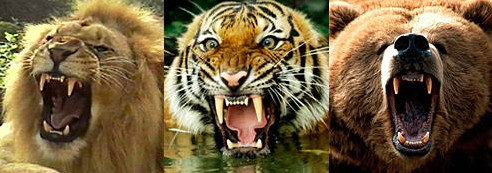Who Would Win in a Fight?
December 6, 2018
Who would win in a fight: a lion, a tiger or a bear? Although the answer to this age-old question is purely subjective, I have determined with the most certainty that neither the lion nor the tiger would win in a fight with the bear (assuming that the strongest of each species was taken into account). First, let’s compare the smaller of the two creatures: the lion and the tiger. It’s important to point out that the average size of the largest of the species varies greatly. Weighing approximately 500 lbs with a length of nearly 9.18 feet long, the Asiatic lion is still no match to the giant Siberian tiger, whose average weight clocks in at around 700 lbs, complementing its 11-foot frame (Bradford, Alina & Siberian Tiger Facts). In addition to this weight and length difference, the Asiatic lion can reach a tall 4 ft height (from the ground to its shoulders), while the Siberian tiger’s height only reaches around 3 ft (Siberian Tiger–the Largest Tiger & Asiatic Lion). This height difference may outwardly appear to be an advantage for the lion, however, I believe that it’s because of the tiger’s shorter height that its center of gravity is equally low, attributing to its advantageous agility. Besides the basic physical advantages, numerous historical records exist dating back to the Colosseum where both tigers and lions were often pitted against each other. According to this evidence left behind by the Romans, the tigers would never lose a fight against the lions(Quora).
After establishing that the lion would stand no chance to either the tiger or bear, it’s time to move onto the more pressing match: a fight between the Siberian tiger and the polar bear. Similar to the Siberian tiger, the polar bear is by far the largest species of its family Ursidae. Weighing a colossal 1700 lbs, with a height of 5 feet and a length double to that, this bear is a monstrosity of a creature (Bradford, Alina & Polar Bear Facts). Unlike its American counterpart, the grizzly bear, polar bears do not rely on foraging when maintaining their diet, but rather hunting. In order to keep up with their necessary caloric intake, these creatures must consume nearly 4 lbs of seal fat each day, a feat which can only be accomplished through aggressive hunting tactics (Polar Bear Facts). Besides providing the polar bear with warmth and energy, this fat also serves as a preventative barrier against attacking creatures that attempt to grip at its neck (a common hunting method used primarily by tigers and other big cats (Siberian Tiger–the Largest Tiger)). Although both creatures share a similar level of aggressiveness as apex hunters, the polar bear is in an entire class of its own because of its sheer size.
Works Cited
“Asiatic Lion.” Wikipedia, Wikimedia Foundation, 3 Dec. 2018, en.wikipedia.org/wiki/Asiatic_lion.
Bradford, Alina. “Lions: Facts & Information.” LiveScience, Purch, 2 Oct. 2014, www.livescience.com/27404-lion-facts.html.
Bradford, Alina. “Polar Bear Facts.” LiveScience, Purch, 24 Nov. 2014, www.livescience.com/27436-polar-bear-facts.html.
Quora. “If a Tiger Fought a Lion, Which Animal Would Win?” The Huffington Post, TheHuffingtonPost.com, 7 Dec. 2017, www.huffingtonpost.com/quora/if-a-tiger-fought-a-lion_b_3348978.html.
“Siberian Tiger Facts | Amur Tigers | Endangered Animals.” Animal Fact Guide, 20 Mar. 2018, animalfactguide.com/animal-facts/siberian-tiger/.
“Siberian Tiger – the Largest Tiger.” DinoAnimals.com, DinoAnimals.com, 12 Apr. 2016, dinoanimals.com/animals/siberian-tiger-the-largest-tiger/.
